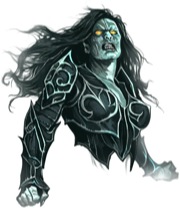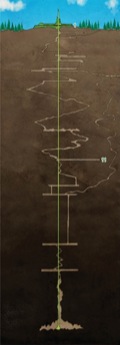All good things must come to an end, and this week we look at the end (or at least, the lowest level) of the Emerald Spire. Of course, the end of a superdungeon is something a lot of players never get to see (as Erik Mona discussed a bit in his teaser last week), so we also thought we might expand this sneak peek to include two maps from the adventure.
When discussing the fact that every dungeon level had to fit on a Flip-Mat, Erik briefly mentioned that this requirement drove our authors to find creative ways to get the most out of the space available. One good example of this is The Clockwork Maze, which has sections likely to initially confuse the players and that are certain to force players to work harder than a typcial ten foot wide corridor. We don’t want to give away the whole secret of the level, but a glance at the map is a pretty big hint why the level has "clockwork" in its title.
Other levels use the available space on a Flip-Map in a more traditional way, but include multiple environments, hazards, and unusual geometry to increase the variety available in the dungeon experience. The final level of the dungeon, The Emeral Root, is a good example of this kind of creative map.
Of course even a great map isn’t very useful if you don’t have enounters to fill it with. To learn a little more about these levels and how they came to be, we we spoke to the CEO and Publisher of Sasquatch Game Studio LLC, Richard Baker, and our own Creative Director, James Jacobs.
How do you define a "Superdungeon"? What is your favorite dungeon or superdungeon experience in your personal gaming history?
Rich To me, a superdungeon is any adventure that you could reasonably base a whole campaign around. It will provide months and months of play, characters will level up a good 8 or 10 times in the course of the game, and the players are up against an epic threat or fighting their way through a truly amazing setting. I suppose I might further refine that by saying that a super-dungeon does that all in the context of a single sprawling underground maze (you can certainly have super-adventures that do the same thing but across multiple locales). So, it's a particular flavor of super-adventure, I guess.
My personal favorites were Undermountain—really the gold standard of superdungeons, even if a lot of the map was left for the DM to populate—and more recently City of the Spider-Queen, which is probably more of a superadventure. When I was developing that adventure, we had James Wyatt (the adventure author) run it for us with a great group of players, and we had a blast.James I define a Superdungeon as a dungeon that you can run an entire campaign in. My favorite superdungeon is Greyhawk’s Maure Castle, which was featured several times in Dungeon magazine back in the day. On Golarion, though, my favorite superdungeon is Hollow Mountain, and I hope to some day get to personally design and develop that site into a significant adventure location. At which point I can see it supplanting Maure Castle as my favorite. Unless I do the same for the Crimson Citadel first, that is.
What is your level of the Emerald Spire Superdungeon called? What theme, if any, does the level have?
Rich My level of Emerald Spire is the Clockwork Maze. This is the lair of the first major villain in the Spire, the Numerian wizard Klarkosh. As you might expect, it has a strong clockwork theme—the entire dungeon configuration can be altered by using control levers in different spots. In fact, the players will have to do just a little bit of puzzle-solving to figure out how to change the dungeon geometry to navigate through the level. The monsters are mostly constructs of different kinds, since Klarkosh was previously described as a master of making constructs.
I also wrote the description of Fort Inevitable that begins the adventure, and did most of the coordination and direction for the whole project. I got to see each author's contribution as they came up with it!James My level of the Emerald Spire is the final one—the "Emerald Root." It’s theme is hard to divulge without revealing a lot of spoilers, since it contains the source and reason and history of the Emerald Spire itself, but it goes beyond that and reveals some key bits of information about the Darklands—particularly the vaults of Orv. In fact, the opportunity to explore some of the mysteries of these vaults is the primary reason I pounced on designing the lowest level of Emerald Spire in the first place.
What where the inspirations you drew on for your Emerald Spire level, and what are you hoping players get out of it?
Rich My primary inspiration was really just delivering on what had already been said about the Spire. In the Thornkeep sourcebook we mentioned a few key facts about the Spire, so I took it upon myself to make sure the Emerald Spire superdungeon delivered on those teasers. For the villain, I admit I was thinking of Tharok, the half-robot leader of the Fatal Five, the arch-enemies of the Legion of Superheroes. Klarkosh is kind of a magical version of Tharok.
James There’s a fair amount of Lovecraft inspiration in my level of Emerald Spire, both in the monster mix and in the story beyond what’s going on in that level, but that also ties in to some of the deep continuity of the history of Orv and the Darklands themselves. And by "Lovecraft" in this case, I’m not talking about Cthulhu and tentacle monsters, but about the idea that humanity was not the first to rise to power on this ball of dirt (Earth) or that ball of dirt (Golarion) hurtling blindly through the uncaring gulfs of space.
We really appreciate our Creative Director and the Chief Sasquatch (Editorial Note, Rich told me to call him this) taking time out of their busy schedules to share some of the Emerald Spire with us!
Owen K.C. Stephens
Developer














